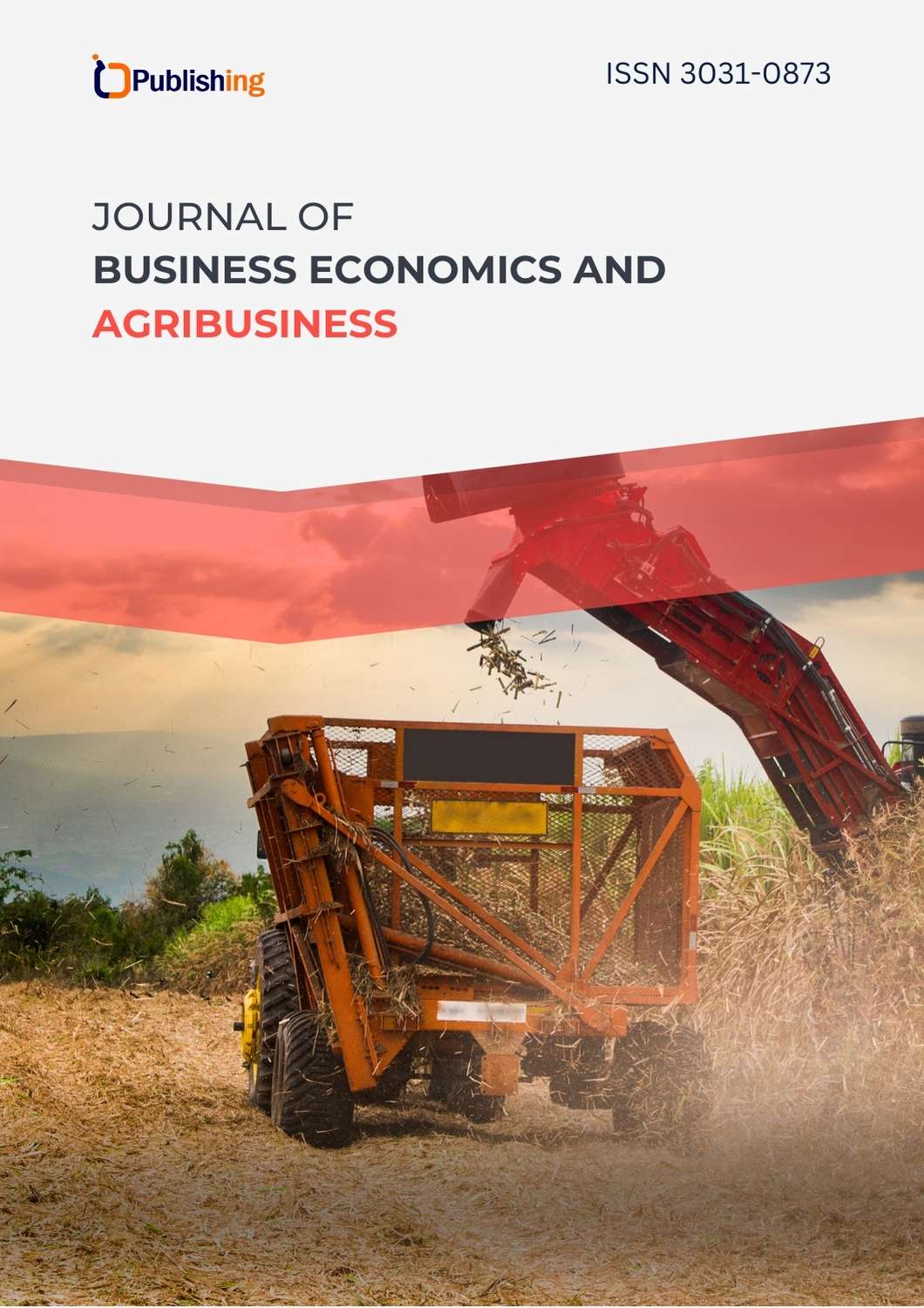The Effect of Storage Conditions and Periods on The Laboratory and Field Efficacy of Some Insecticides
DOI:
https://doi.org/10.47134/jbea.v2i4.787Keywords:
Pesticides, Chemical Pesticides, Pesticide Effectiveness, Pesticide Thiamethoxam, Pesticide Abamectin, Lambda-Cyhalothrin, Neonicotinoid, PyrethroidAbstract
This study investigates the impact of storage temperature on the physical stability and insecticidal efficacy of selected pesticide emulsions. Laboratory results revealed a consistent increase in the separation layer thickness of pesticide formulations stored under both high (50°C) and low (-5°C) temperatures. The impact was more severe at elevated temperature, where the thickness exceeded the permissible limit of 2 cm for thiamethoxam and abamectin after three months of storage, and for lambda-cyhalothrin after two and three months. In contrast, cold storage at -5°C maintained the separation layer within acceptable specifications for all tested pesticides. A strong negative correlation was observed between separation layer thickness and insecticidal efficacy, with longer storage durations leading to greater physical degradation. These findings suggest that high temperatures accelerate chemical degradation or alter the target insect's response, ultimately reducing pesticide performance. This outcome aligns with previous research by Bajwa and Sandhu (2014), Laskowski et al. (2017), and Scott & Georghiou (1986), who reported that elevated storage temperatures induce physical changes—such as increased viscosity and phase separation—which directly affect the pesticide's stability and bioefficacy. Although cold storage also caused physical changes, its impact on efficacy was less pronounced. Prior studies (University of Minnesota Extension, 2020) (Guo et al, 2018) confirm that temperatures below 5°C may lead to phase separation, crystallization of active ingredients, and increased viscosity, which could reduce pesticide uniformity and effectiveness upon application. In conclusion, while both high and low temperatures influence the physical properties of pesticide formulations, elevated temperature poses a greater risk to their stability and efficacy, highlighting the critical importance of optimal storage conditions.
References
Ahmad, A. S. (2025). Combined effects of pulsed electric field and soursop leaf extract treatment and modified atmosphere packaging on melanosis inhibition and shelf-life elongation of Pacific white shrimp during refrigerated storage. Innovative Food Science and Emerging Technologies, 100, ISSN 1466-8564, https://doi.org/10.1016/j.ifset.2024.103903
Akbar, R., Khan, I. A., Alajmi, R. A., Ali, A., Faheem, B., Usman, A., Ahmed, A. M., El-Shazly, M., Farid, A., & Giesy, J. P. (2022). Evaluation of insecticidal potentials of five plant extracts against the stored grain pest, Callosobruchus maculatus (Coleoptera: Bruchidae). Insects, 13, 1047. https://doi.org/10.3390/insects13111047
Araújo, R. S. (2023). Effect of Pesticides and a Long-Life Inoculant on Nodulation Process and Soybean Seed Quality during Storage. Agronomy, 13(9), ISSN 2073-4395, https://doi.org/10.3390/agronomy13092322
Augustine, N., & Balikai, R. A. (2019). Biology of pulse beetle, Callosobruchus chinensis (Linnaeus) on cowpea variety DC-15. Journal of Entomology and Zoology Studies, 7(1), 513–516.
Butt, Z. I. (2024). MHD slip flow through nanofluids for thermal energy storage in solar collectors using radiation and conductivity effects: A novel design sequential quadratic programming-based neuro-evolutionary approach. Modern Physics Letters B, ISSN 0217-9849, https://doi.org/10.1142/S0217984925500757
Carvalho, F. P. (2017). Pesticides, environment, and food safety. Food and Energy Security, 6, 48–60. https://doi.org/10.1002/fes3.108
CLI-SE. (2021). Guidelines for specifying and managing shelf life and expiry date of crop protection product (Technical Monograph No. 17, 3rd ed., 20 pp.). CropLife International.
FAO/WHO. (2016). Manual on development and use of FAO and WHO specifications for pesticides (3rd rev. ed., 228 pp.). Rome: FAO Plant Production and Protection.
Fernández-Alba, A. R., & García-Reyes, J. F. (2008). Large-scale multi-residue methods for pesticides and their degradation products in food by advanced LC-MS. Trends in Analytical Chemistry, 27(11), 973–990.
Fishel, F. M. (2016). Pesticide toxicity profile: Neonicotinoid pesticides. University of Florida. Accessed from http://edis.ifas.ufl.edu/pi117
Hamza, A. M. (2017). Natural products for controlling sitophilus oryzae with respect to the effect of storage conditions and grain type. Egyptian Journal of Biological Pest Control, 27(2), 245-253, ISSN 1110-1768, https://www.scopus.com/inward/record.uri?partnerID=HzOxMe3b&scp=85025658800&origin=inward
Hanan, S. T., Naglaa, K. Y., & Olfat, A. R. (2016). Effect of storage on the stability and biological effectiveness of some insecticides. Journal of Biological Chemistry and Environmental Science, 11(2), 265–282.
Khamis, W. M., El-Sabrout, A. M., Shahin, R., & others. (2023). Field efficacy, sub-lethal, and biochemical effects of certain biorational insecticides against the new intruder, Spodoptera frugiperda in Bani-Suef, Upper Egypt. Neotropical Entomology, 52, 963–973. https://doi.org/10.1007/s13744-023-01064-y
Mrda, J. (2010). Effect of storage period and chemical treatment on sunflower seed germination. Helia, 33(53), 199-206, ISSN 1018-1806, https://doi.org/10.2298/HEL1053199M
Naglaa, K. Y., & Olfat, A. R. (2021). Effect of storage temperature conditions on the stability and biological effectiveness of insecticide formulation. Egyptian Journal of Plant Protection Research Institute, 4(3), 426–431.
Rivera, P. (2014). Effect of vacuum storage on shelf life of a grain protector based on Peumus boldus molina foliage powder and lime against Sitophilus zeamais motschulsky. Chilean Journal of Agricultural Research, 74(1), 49-54, ISSN 0718-5820, https://doi.org/10.4067/S0718-58392014000100008
Roberts, J. R., & Karr, J. C. (2012). Pesticide exposure in children. Pediatrics, 130(6), e1765–e1788. https://doi.org/10.1542/peds.2012-2758
Shinde, P. (2024). Effect of Modified Atmosphere Storage Conditions on Seed Quality and Longevity of Kabuli Chickpea Varieties. Indian Journal of Agricultural Research, 58(4), 566-575, ISSN 0367-8245, https://doi.org/10.18805/IJARe.A-5785
Stejskal, V. (2021). Sensitivity of polyphagous (Plodia interpunctella) and stenophagous (Ephestia kuehniella) storage moths to residual insecticides: effect of formulation and larval age. Insect Science, 28(6), 1734-1744, ISSN 1672-9609, https://doi.org/10.1111/1744-7917.12889
World Health Organization (WHO). (2003). Guidelines on the management of public health pesticides. Geneva: WHO.
Zhao, J. (2024). Experimental study on effect of an active solar heating soil heat storage system on the thermal environment in Gobi solar greenhouses. Energy and Buildings, 325, ISSN 0378-7788, https://doi.org/10.1016/j.enbuild.2024.115055









